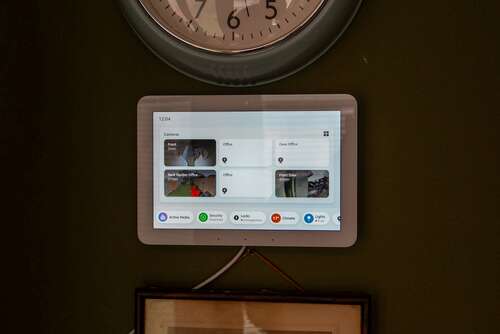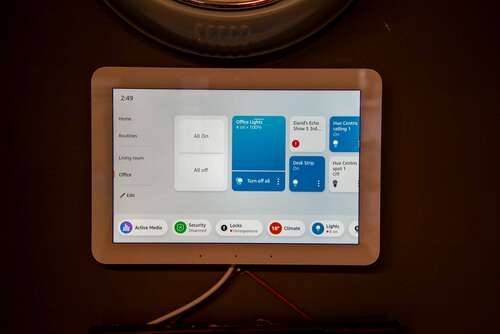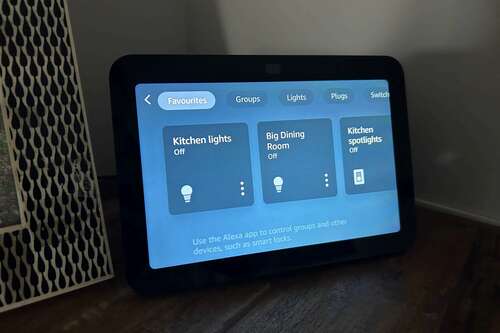All Echo devices house Amazon’s voice assistant, Alexa, but each Echo has different additional features which can make deciding between them difficult.
How does the newly launched Amazon Echo Hub differ from the Amazon Echo Show 8 (3rd Gen)? We’ve compared the features of each Echo and highlighted their key differences to help you decide which one is a better fit for you.
Pricing and availability
The Amazon Echo Hub launched in February 2024 and is currently retailing for £169.99/$179.99/€169.99.
Just a few months older, the Echo Show 8 (3rd Gen) launched in October 2023 and is currently retailing for £149.99/$149.99/€169.99.
Design
One of the main similarities between the Echo Hub and Echo Show 8 (3rd Generation) is their 8-inch touchscreen, with a decent 1280×800 HD resolution. However, they both differ otherwise in their appearance.
The Echo Hub looks more like a tablet and is just 15mm thick, whereas the Echo Show 8 has a deeper body that houses its speakers. The Echo Hub also ships with a dedicated wall-mount, whereas the Echo Show 8 is designed to be stood on a desk or countertop.
The Show 8 also has a 13MP front-facing camera that occupies the central spot on the top bezel, whereas the Echo Hub is camera-less. The Show 8’s 13MP camera central placement is particularly useful for video calling, with app support for Alexa Calling and Skype. There’s also built-in auto-tracking technology which ensures the camera zooms in to follow your movements during the call.
Both the Echo Hub and Echo Show 8 have their control buttons on the side, a convenient difference from previous Echos where control buttons were found at the top.


Features
As both the Echo Hub and Echo Show 8 are Alexa-powered smart speakers, you’ll find all the typical Alexa features on both devices, which can all be controlled with just your voice.
Even so, the Echo Hub especially makes sure to utilise its touchscreen. In his review of the Echo Hub, David Ludlow highlighted that “its new touch interface makes the complex easy, and I found it faster to use than voice control in most cases.” The Hub is designed to manage all of your different smart home devices from one display, acting as the main hub of your smart home.
In comparison, the Echo Show 8 is designed to work independently, acting like your average Alexa speaker to answer questions and complete simple jobs like activating timers or your smart lights. The screen is used to display notifications or make video calls, while the Echo Hub’s screen is more useful for keeping tabs of other Amazon devices, like the security feed of a camera or your smart doorbell.
Paul Lamkin, in his review of the Echo Show 8, found that although the “smart home controls on offer are pretty good” he would have ‘liked to have been able to permanently pin some controls to the homescreen’ as accessing some controls required extra screen taps.
Both Echo devices are also Matter-compatible, and support direct control of Wi-Fi and Thread devices, plus there’s support for Bluetooth devices. All of this can easily be found on the Echo Hub’s new interface.
Display
The Echo Hub’s new interface is a huge change from its predecessors, and is particularly useful for households with lots of smart devices. When not in use, the Echo Hub has a choice of screens to show, including news reports and photos.
Widgets on the Echo Hub are shown on the home screen, where you’ll also find direct access to the smart home controls. This differs to the Echo Show 8 however, as widgets don’t stay permanently on the screen, which does add an extra step or two when accessing controls.
The Echo Hub is a dedicated smart home hub as it features a useful All On/All Off set of controls, which means you can quickly turn all your smart devices on and off with just one tap. There are also individual controls for each device and group too.


Sound
If you intend on using an Echo for audio listening, the Echo Show 8 is the better choice. The Show 8 has dual 2-inch neodymium stereo speakers, paired with a passive bass radiator. Not only that, but the Show 8 also includes spatial audio processing technology which enhances sound and creates a more immersive audio experience.
Thanks to room adaption technology, audio playback is fine-tuned for optimal sound which, although doesn’t compete with dedicated speakers, “offers a pretty robust audio quality”.
In comparison, the Echo Hub has a pair of full-range speakers. David Ludlow concluded that while they’re “fine for basic Alexa replies, the sound was muddled and a bit tinny for music playback”.

